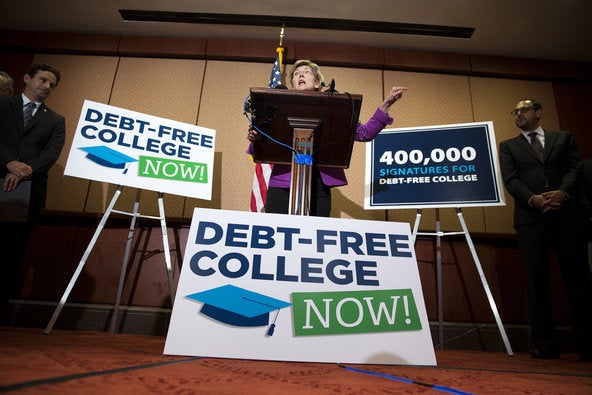Via Buzzfeed News
By: Molly Hensley-Clancy
In 2015, when she found herself on Air Force One with then-president Barack Obama, Sen. Elizabeth Warren seized the chance to pressure the most powerful man in the world about an obscure part of federal tax law.
Warren — along with activists, consumer lawyers, and a group of other Democratic senators — was in the midst of what would become a years-long fight to get loan forgiveness for tens of thousands of students who had been defrauded by Corinthian Colleges, a collapsed for-profit college chain.
Earlier, Warren and others had helped convince the Education Department to agree to cancel the loans for some of those for-profit college students, opening the door to forgiveness for hundreds of thousands of people. Now, Warren was waging a new battle against Obama’s Treasury Department, which was planning to hit students with steep tax bills on their forgiven loans.
The Treasury was refusing to budge. The agency said it had no choice: The law was the law, and if Warren wanted to stop the students from having to pay taxes, she’d have to convince Congress. Warren had other ideas.
Warren’s policy team had come up with a detailed letter that explained why students should not have to pay taxes on their debts, and how, exactly, the Treasury Department could carry that out. On Air Force One, she went through those points with Obama.
Warren’s goal, according to people familiar with the conversation, was not just to convince Obama that it was possible to do something that his own administration was telling him was impossible. It was to persuade him to spend some of his political capital — which was in short supply as he battled against a Republican Congress — on a group of struggling low-income students who had been defrauded by a now-defunct for-profit college chain.
Implicit in that conversation was a threat: If he didn’t act, Obama could have a public image problem on his hands in the form of a loud, popular senator who had already been raising hell about his Education Department.
Not long after the Air Force One flight, the Treasury Department told Warren it had found a way to stop the students from being hit with tax bills after all.
It was a key victory in Warren’s work on behalf of for-profit college students — a battle that has come to help define who Warren believes the federal government’s power should be used to help, and, more importantly, how best to instigate that change.
BuzzFeed News spoke to activists, consumer lawyers, congressional staffers, and former Obama administration officials about Warren’s work to secure loan forgiveness for Corinthian students, which began in 2014. Warren, they agree, played a pivotal role in the battle.
She did it by turning to what had become the core tool of her political life: a potent combination of grassroots activism, intense political pressure, and detailed analysis of consumer law. And she used that tool in part against her own party’s administration, strengthening a political identity that cut against what was then the mainstream of American liberalism.
Warren took a lasting lesson from the fight, she told BuzzFeed News in a recent interview, one that is now central to her presidential campaign: “Progress in America doesn’t happen without a grassroots army.”
But for someone who often presents herself as a political outsider, Warren also worked extensively within the boundaries of power to help get Corinthian students loan forgiveness — an approach that draws a contrast with Sen. Bernie Sanders, who has put far greater focus on large-scale outside pressure than on internal movements and incremental details.
One former Education Department official called it an “inside/outside strategy”: Warren would hammer the administration publicly at the same time she worked behind the scenes with those government officials, acting, many felt, as an ally.
In the end, the drawn-out political battle resulted in something that was entirely unprecedented: the loans of at least 30,000 students who were defrauded by Corinthian and other for-profit schools were wiped out entirely, at a cost to taxpayers that is in the hundreds of millions of dollars.
“It’s really easy and popular today to take punches at Betsy DeVos,” said Eileen Connor, an attorney at Harvard University’s Project on Predatory Lending who works on behalf of for-profit college students, of President Donald Trump’s education secretary. “But Sen. Warren was in the fight even when the administration was run by Democrats.”
…
An often overlooked detail of the Corinthian fight, attorney Eileen Connor said, was how Warren personally involved herself with individual students. Warren hosted a clinic in Massachusetts alongside the state attorney general, Maura Healey, to help students file borrower discharge paperwork. After Warren’s office worked with Connor to collect and document the stories of defrauded borrowers, Warren’s staffers sent signed copies of the report they produced to each of the students they had spoken with.
“That speaks volumes,” Connor said.
Filed in: In the News
Tags: Eileen Connor, Predatory Lending and Consumer Protection Clinic
Contact Office of Clinical and Pro Bono Programs
Website:
hls.harvard.edu/clinics
Email:
clinical@law.harvard.edu
